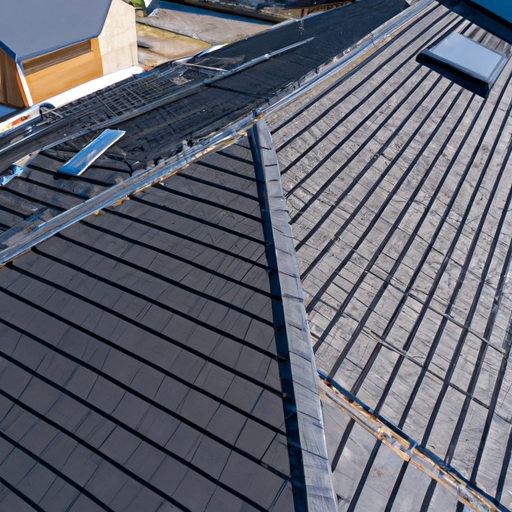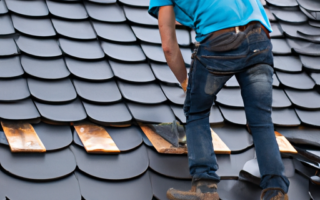Understanding the Different Types of Roofs in Construction
Understanding the different types of roofs in construction is essential for any homeowner or builder. The roof is an integral part of any building, protecting it from the elements and providing structural support. There are various types of roofs, each with its own unique characteristics and advantages. In this comprehensive guide, we will delve into the basics of roof construction and explore the different types of roofs commonly used in the industry.
Gable Roof
One of the most popular and recognizable types of roofs is the gable roof. It features two sloping sides that come together at a ridge, forming a triangular shape. Gable roofs offer excellent water drainage, ample attic space, and are relatively simple to construct. However, they may not be suitable for areas prone to high winds.
Hip Roof
A hip roof is characterized by slopes on all four sides, meeting at a central ridge. This design offers superior stability and is ideal for areas with high wind loads. Hip roofs also provide additional living space in the form of attic rooms or vaulted ceilings. Although more complex to construct, their aesthetic appeal and durability make them an attractive choice.
Mansard Roof
The Mansard roof, often referred to as a French roof, is distinguished by its double slopes on all four sides. This design allows for maximum utilization of attic space. Mansard roofs are commonly seen in historical or Victorian-style buildings, adding a touch of elegance and architectural charm. However, their complex design can make repairs and maintenance more challenging.
Gambrel Roof
Similar to the Mansard roof, a gambrel roof features two slopes on each side. The difference lies in the steeper lower slope and a shallower upper slope. Gambrel roofs are commonly found in barns and farmhouse-style buildings, as they provide ample headroom and storage space. They are visually appealing and can accommodate additional windows for enhanced natural lighting.
Flat Roof
In contrast to sloped roofs, flat roofs have a minimal slope, often with a slightly pitched surface for water drainage. Flat roofs are popular in commercial and modern residential buildings, as they provide a clean, minimalist appearance. They are also cost-effective and easier to maintain. However, proper installation and regular inspections are crucial to prevent water pooling and leaks.
While these are just a few examples, understanding the different types of roofs in construction is vital when planning a new build or renovating an existing structure. Factors such as climate, building aesthetics, budget, and maintenance requirements should all be considered to determine the most suitable roof style for your project.
Key Elements of an Effective Roofing System
The roof is one of the most crucial components of any building structure, providing protection and insulation from the elements. To ensure its effectiveness and longevity, an effective roofing system should consist of several key elements. Let’s take a closer look at these essential components that form a well-constructed and reliable roof.
1. Roof Deck
The roof deck is the foundation of the entire roofing system. It refers to the surface, typically made of wood or metal, that covers the structural supports of the roof. The deck serves as a base for the other roofing components to be installed on, providing structural stability and support.
2. Underlayment
The underlayment is a water-resistant or waterproof material that is installed directly on top of the roof deck. It acts as a secondary layer of protection against moisture, preventing water from reaching the underlying structure of the roof. Commonly used underlayment materials include asphalt-saturated felt, synthetic materials, or rubberized asphalt membranes.
3. Roof Covering
The roof covering is the outermost layer of the roofing system, which provides the primary defense against weather elements such as rain, snow, and wind. Different types of materials can be used for the roof covering, including asphalt shingles, metal panels, clay tiles, slate, or concrete. The choice of the roof covering material depends on factors such as cost, durability, aesthetics, and climate conditions.
4. Flashing
Flashing is a crucial component that helps to prevent water from seeping into the vulnerable areas of the roof, such as joints, valleys, and intersections. It is typically made of metal, such as aluminum or copper, and is installed in overlapping layers. Flashing ensures a watertight seal and directs water away from critical areas, protecting the roof from leaks and potential damage.
5. Ventilation
A proper ventilation system is essential for maintaining a healthy and efficient roofing system. It allows for the exchange of air, preventing the buildup of excess heat and moisture in the attic space. Adequate ventilation helps to prevent the formation of condensation, mold, and rot, prolonging the lifespan of the roof. Ventilation can be achieved through vents installed along the eaves, ridges, or the use of mechanical ventilation systems.
6. Gutters and Downspouts
Gutters and downspouts play a crucial role in directing rainwater away from the roof and the foundation of the building. They collect water runoff from the roof and channel it towards the downspouts, which then direct it away from the structure. Properly installed gutters and downspouts help prevent water damage to the roof, walls, and foundation, ensuring the overall integrity of the building.
An effective roofing system is a combination of these key elements, working together to provide protection, insulation, and drainage. Each component plays a vital role, and any compromise in their quality or installation can lead to potential problems, such as leaks, structural damage, or decreased energy efficiency. Therefore, it’s crucial to ensure that each element is carefully selected, installed, and maintained to maximize the lifespan and performance of the roof.
The Importance of Proper Roof Design and Structural Integrity
In the world of construction, the roof plays a critical role in protecting a building and its occupants from the elements. A properly designed and structurally sound roof is essential for ensuring the longevity and safety of any structure. The importance of proper roof design and structural integrity cannot be overstated.
One of the key aspects of roof construction is the design phase. A well-designed roof takes into consideration various factors such as local climate, building codes, and the specific needs of the structure. The design should aim to create a roof that is not only aesthetically pleasing but also functional and durable.
The structural integrity of a roof is crucial for its ability to withstand external forces such as wind, snow, and rain. A weak or poorly constructed roof can lead to leaks, water damage, and even collapse. This is why it is essential to ensure that the roof’s structure is adequately designed and constructed.
One of the primary components of a roof’s structure is the framing system. The framing system provides the backbone of the roof and distributes the weight of the roof evenly across the supporting walls or columns. Common types of roof framing systems include trusses, rafters, and joists. Each type has its own advantages and is suited for different types of structures.
In addition to the framing system, other elements such as roof decking, underlayment, and roofing materials contribute to the overall structural integrity of the roof. The roof decking serves as the base for the roof covering and provides support for the roofing materials. It is typically made from plywood or oriented strand board (OSB).
The underlayment is a waterproof or water-resistant barrier that is installed directly on top of the roof decking. It provides an additional layer of protection against moisture and helps to keep the interior of the building dry. Common types of underlayment include asphalt-saturated felt and synthetic materials such as rubberized asphalt.
Finally, the choice of roofing materials is another crucial factor in ensuring the structural integrity of a roof. There are various options available, including asphalt shingles, metal, tile, and slate. The selection of roofing materials should consider factors such as durability, maintenance requirements, and compatibility with the overall design of the structure.
In conclusion, proper roof design and structural integrity are essential for any construction project. A well-designed roof that is structurally sound can provide years of reliable protection for a building and its occupants. By considering factors such as climate, building codes, and the specific needs of the structure, construction professionals can create roofs that are not only functional but also aesthetically pleasing.
Exploring Modern Roofing Materials and Technologies
When it comes to roof construction, one of the most important aspects to consider is the type of materials and technologies that are used. With advancements in modern construction, there are now a wide variety of roofing materials and technologies available, each with their own unique properties and benefits.
One of the most popular roofing materials used today is asphalt shingles. These shingles are made from a fiberglass base that is coated with asphalt and granules, providing excellent durability and protection against the elements. Asphalt shingles are also relatively affordable and easy to install, making them a common choice for residential roofing projects.
Metal roofing is another modern option that has gained popularity in recent years. This type of roofing is made from durable metals such as steel, aluminum, or copper, and offers superior strength and longevity. Metal roofs are known for their resistance to fire, extreme weather conditions, and pests. Additionally, they can be designed in various styles to enhance the aesthetic appeal of a property.
For environmentally-conscious homeowners, green roofing materials have become increasingly popular. These materials include vegetation, such as grass or plants, that are grown on specially-designed roofing systems. Green roofs provide numerous benefits, including improved insulation, reduced stormwater runoff, and enhanced air quality. They also add beauty to urban landscapes and promote biodiversity.
Technological advancements have also impacted roofing construction. Solar panels have become a common addition to roofs, allowing homeowners to harness the power of the sun and reduce their reliance on traditional energy sources. These panels are designed to convert sunlight into electricity, providing a renewable and eco-friendly source of energy. In addition to being environmentally-friendly, solar panels can also save homeowners money on their energy bills over time.
Another technological advancement in roofing is the use of smart roof systems. These systems integrate sensors and monitoring devices to provide real-time data on the condition of the roof, including temperature, moisture levels, and potential damage. Homeowners can receive alerts and notifications regarding any issues, allowing for prompt maintenance and repairs. Smart roof systems help to prolong the lifespan of the roof and ensure its optimal performance.
Exploring modern roofing materials and technologies is essential for anyone involved in roof construction or considering a roof replacement. By understanding the benefits and properties of different materials, as well as the advancements in technology, homeowners can make informed decisions and choose the most suitable option for their needs and preferences.



